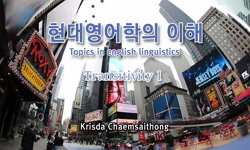This study deals with the copula i-da(이다) which has various meanings. So this borrowed the prototype theory of cognitive linguistics for finding the most fundamental sense and elicited various meanings expanded radially. After that, this went thr...
http://chineseinput.net/에서 pinyin(병음)방식으로 중국어를 변환할 수 있습니다.
변환된 중국어를 복사하여 사용하시면 됩니다.
- 中文 을 입력하시려면 zhongwen을 입력하시고 space를누르시면됩니다.
- 北京 을 입력하시려면 beijing을 입력하시고 space를 누르시면 됩니다.
https://www.riss.kr/link?id=T15059709
- 저자
-
발행사항
서울 : 韓國外國語大學校 敎育大學院, 2019
-
학위논문사항
학위논문(석사) -- 韓國外國語大學校 敎育大學院 , 외국어로서의한국어교육전공 , 2019. 2
-
발행연도
2019
-
작성언어
한국어
- 주제어
-
DDC
495.107 판사항(22)
-
발행국(도시)
서울
-
기타서명
A cognitive linguistic study on the meanings of copula i-da(이다) for teaching Korean as a foreign language
-
형태사항
116p. : 삽도 ; 26 cm
-
일반주기명
한국외국어대학교 논문은 저작권에 의해 보호받습니다.
지도교수: 정해권
참고문헌: p. 102-108 -
UCI식별코드
I804:11059-200000177993
- 소장기관
-
0
상세조회 -
0
다운로드
부가정보
다국어 초록 (Multilingual Abstract)
I-da(이다) penetrates a wide range from beginner to advanced. So it is extensively utilized in the real life and is often used in actual discourse situations, including textbooks. However, learners constantly make mistakes in relation to it from beginner’s to advanced level, because it is concentrated only on beginner’s level and presented as a syntax type in current Korean textbooks. This method makes learners perceive ‘one’ i-da(이다) as ‘another’. So learners are hard to comprehensively understand i-da(이다) with various meanings.
Therefore, in contrast to the Korean academic field which focuses on the grammar category setting of i-da(이다), this study has focused on finding various meanings, searching for the prototype. Research on i-da(이다) has mainly focused on morphological viewpoints and syntactic activities so far, but this study deals with it at the semantic level.
Learners first learn the most fundamental meaning of prototype. And the meaning of the prototype establishes the polysemy through conceptual metaphor, conceptual metonymy and conceptual blending. Through this extension mechanism, the radiation category of meanings of i-da(이다) is expanded step by step, from identification to class membership, existence, location, possession, quantification, ascription, psychology, repetition, state, time, presentation, emphasis and relatedness.
In order to find out if the education by meaning classification is done, it is necessary to investigate the situation in actual education field. Consequently this study dealt with text analysis, learner error corpus analysis, questionnaire survey. Through these analysis of errors caused by learners, this study judged that learners did not correctly recognize the meaning of i-da(이다), and accordingly proposed a method and an educational arrangement which effectively suggests the various meanings of it to Korean learners.
If Korean learners understand the polysemy of i-da(이다) and the customary way of expanding meanings in depth, they can apply various types of it in the actual discourse situation and it will lead to the enhancement of communication ability.
Finally, this study could be a valuable resource as a study on i-da(이다) and cognitive linguistics.
This study deals with the copula i-da(이다) which has various meanings. So this borrowed the prototype theory of cognitive linguistics for finding the most fundamental sense and elicited various meanings expanded radially. After that, this went through a course of text analysis, learner error corpus analysis, questionnaire survey and suggested an educational arrangement about it. All of these processes were for finding how to teach the copula i-da(이다) effectively.
I-da(이다) penetrates a wide range from beginner to advanced. So it is extensively utilized in the real life and is often used in actual discourse situations, including textbooks. However, learners constantly make mistakes in relation to it from beginner’s to advanced level, because it is concentrated only on beginner’s level and presented as a syntax type in current Korean textbooks. This method makes learners perceive ‘one’ i-da(이다) as ‘another’. So learners are hard to comprehensively understand i-da(이다) with various meanings.
Therefore, in contrast to the Korean academic field which focuses on the grammar category setting of i-da(이다), this study has focused on finding various meanings, searching for the prototype. Research on i-da(이다) has mainly focused on morphological viewpoints and syntactic activities so far, but this study deals with it at the semantic level.
Learners first learn the most fundamental meaning of prototype. And the meaning of the prototype establishes the polysemy through conceptual metaphor, conceptual metonymy and conceptual blending. Through this extension mechanism, the radiation category of meanings of i-da(이다) is expanded step by step, from identification to class membership, existence, location, possession, quantification, ascription, psychology, repetition, state, time, presentation, emphasis and relatedness.
In order to find out if the education by meaning classification is done, it is necessary to investigate the situation in actual education field. Consequently this study dealt with text analysis, learner error corpus analysis, questionnaire survey. Through these analysis of errors caused by learners, this study judged that learners did not correctly recognize the meaning of i-da(이다), and accordingly proposed a method and an educational arrangement which effectively suggests the various meanings of it to Korean learners.
If Korean learners understand the polysemy of i-da(이다) and the customary way of expanding meanings in depth, they can apply various types of it in the actual discourse situation and it will lead to the enhancement of communication ability.
Finally, this study could be a valuable resource as a study on i-da(이다) and cognitive linguistics.
목차 (Table of Contents)
- 1. 서론 1
- 1.1. 연구 목적 1
- 1.2. 선행 연구 2
- 1.3. 연구 방법 5
- 2. 이론적 배경 7
- 1. 서론 1
- 1.1. 연구 목적 1
- 1.2. 선행 연구 2
- 1.3. 연구 방법 5
- 2. 이론적 배경 7
- 2.1. 원형 이론 7
- 2.2. 방사 범주 10
- 2.3. 의미 확장 메커니즘 14
- 2.4. 원칙적 다의성 접근법 18
- 3. ‘이다’의 의미 분석 21
- 3.1. ‘이다’의 형태적 분류 21
- 3.2. ‘이다’의 의미 구분 30
- 3.3. ‘이다’ 의미의 재설정 37
- 4. 한국어 교육에서의 ‘이다’ 47
- 4.1. 사전과 문법서에서의 ‘이다’ 47
- 4.2. 교재에서의 ‘이다’ 57
- 4.3. 한국어 학습자의 ‘이다’ 오류 유형 69
- 5. 한국어 교육을 위한 ‘이다’ 의미의 제시 87
- 5.1. ‘이다’ 의미 제시 방법 87
- 5.2. ‘이다’ 의미 교육 배열 92
- 6. 결론 98
- 참고 문헌 102
- ABSTRACT 114












